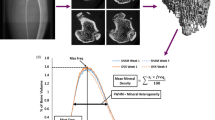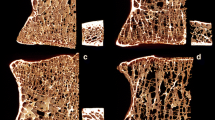Abstract
Bone histomorphometry is usually performed on the iliac bone in humans and the tibia or vertebrae in rats. Bone metabolism differences among skeletal sites may be problematic when translating experimental results from rats to humans, but data on such differences in rats are lacking. Therefore, we examined the differences in bone structure and metabolism among skeletal sites using the lumbar vertebra (LV), tibia, and iliac bone obtained from ovariectomized or sham-operated rats preoperatively and at various times from 3 days to 26 weeks postoperatively. The trabeculae were thicker in the LV, where bone metabolism was less active than at other sites, and numerous fine trabeculae were observed in the tibia, where bone metabolism was more active. The iliac bone structure and metabolism were intermediate between those of the tibia and LV. Ovariectomy induced lower bone volume and higher bone metabolism in all skeletal sites, but the changes were greatest and occurred earliest in the tibia, followed by the iliac bone and then LV. Ovariectomy caused changes in bone metabolic markers, which occurred earlier than those in bone tissue. Activation frequency (Ac.f) increased after ovariectomy. At week 26 in ovariectomized rats, Ac.f was highest in the tibia (3.13 N/year) but similar between iliac bone (0.87 N/year) and LV (1.39 N/year). Ac.f is reportedly 0.3–0.4 N/year in the iliac bone of postmenopausal women, suggesting that bone turnover in rats is several times higher than in humans. The reference values reported here are useful for translating experimental results from rats to humans.


Similar content being viewed by others
References
Food and Drug Administration Division of Metabolic and Endocrine Drug Products (1994) Guideline for preclinical and clinical evaluation of agents used in the prevention or treatment of postmenopausal osteoporosis
World Health Organization (1998) Guidelines for preclinical and clinical trials in osteoporosis
Ministry of Health Labour and Welfare of Japan Evaluation and Licensing Division of the Pharmaceutical and Food Safety Bureau (1999) Guideline on clinical evaluation of drugs to treat osteoporosis. PFSB/ELD Notification No. 742
Smith SY, Recker RR, Hannan M, Muller R, Bauss F (2003) Intermittent intravenous administration of the bisphosphonate ibandronate prevents bone loss and maintains bone strength and quality in ovariectomized cynomolgus monkeys. Bone 32:45–55
Wronski TJ, Cintron M, Dann LM (1988) Temporal relationship between bone loss and increased bone turnover in ovariectomized rats. Calcif Tissue Int 43:179–183
Wronski TJ, Dann LM, Horner SL (1989) Time course of vertebral osteopenia in ovariectomized rats. Bone 10:295–301
Hodsman AB, Kiesel M, Fraher LJ, Watson PH, Stitt LW (1998) Comparison of the response of pelvic and proximal tibial cancellous bone in rat to ovariectomy with estrogen replacement. Bone 23:267–274
Tanizawa T, Yamaguchi A, Uchiyama Y, Miyaura C, Ikeda T, Ejiri S, Nagal Y, Yamato H, Murayama H, Sato M, Nakamura T (2000) Reduction in bone formation and elevated bone resorption in ovariectomized rats with special reference to acute inflammation. Bone 26:43–53
Parfitt AM, Drezner MK, Glorieux FH, Kanis JA, Malluche H, Meunier PJ, Ott SM, Recker RR (1987) Bone histomorphometry: standardization of nomenclature, symbols, and units. Report of the ASBMR Histomorphometry Nomenclature Committee. J Bone Miner Res 2:595–610
Dempster DW, Compston JE, Drezner MK, Glorieux FH, Kanis JA, Malluche H, Meunier PJ, Ott SM, Recker RR, Parfitt AM (2013) Standardized nomenclature, symbols, and units for bone histomorphometry: a 2012 update of the report of the ASBMR Histomorphometry Nomenclature Committee. J Bone Miner Res 28:2–17
Li XJ, Jee WS, Ke HZ, Mori S, Akamine T (1991) Age-related changes of cancellous and cortical bone histomorphometry in female Sprague-Dawley rats. Cells Mater 1:25–35
Kimmel DB, Recker RR, Gallagher JC, Vaswani AS, Aloia JF (1990) A comparison of iliac bone histomorphometric data in post-menopausal osteoporotic and normal subjects. Bone Miner 11:217–235
Ma YF, Ke HZ, Jee WS (1994) Prostaglandin E2 adds bone to a cancellous bone site with a closed growth plate and low bone turnover in ovariectomized rats. Bone 15:137–146
Harris ST, Eriksen EF, Davidson M, Ettinger MP, Moffett AH Jr, Baylink DJ, Crusan CE, Chines AA (2001) Effect of combined risedronate and hormone replacement therapies on bone mineral density in postmenopausal women. J Clin Endocrinol Metab 86:1890–1897
Weinstein RS, Parfitt AM, Marcus R, Greenwald M, Crans G, Muchmore DB (2003) Effects of raloxifene, hormone replacement therapy, and placebo on bone turnover in postmenopausal women. Osteoporos Int 14:814–822
Miki T, Nakatsuka K, Naka H, Masaki H, Imanishi Y, Ito M, Inaba M, Morii H, Nishizawa Y (2004) Effect and safety of intermittent weekly administration of human parathyroid hormone 1–34 in patients with primary osteoporosis evaluated by histomorphometry and microstructural analysis of iliac trabecular bone before and after 1 year of treatment. J Bone Miner Metab 22:569–576
Yamazaki I, Yamaguchi H (1989) Characteristics of an ovariectomized osteopenic rat model. J Bone Miner Res 4:13–22
Fukuda S, Iida H (1991) Age and sex-related changes of bone metabolism in normal rats and the effects in ovariectomized and orchidectomized rats at different ages. J Jpn Soc Bone Morphom 1:89–94
Elsubeihi ES, Bellows CG, Jia Y, Heersche JN (2007) Ovariectomy of 12-month-old rats: effects on osteoprogenitor numbers in bone cell populations isolated from femur and on histomorphometric parameters of bone turnover in corresponding tibia. Cell Tissue Res 330:515–526
Acknowledgments
This study was funded by Asahi Kasei Pharma Corporation. The authors thank Hiroshi Kuriyama, VMD., for providing scientific advice; Hideyuki Yamato, Ph.D., from Kureha Corporation for providing technical assistance, and Nicholas Smith, PhD, for providing editorial assistance.
Conflict of interest
Aya Takakura, Ryoko Takao-Kawabata, Yukihiro Isogai, and Toshinori Ishizuya are employees of Asahi Kasei Pharma Corporation. Makoto Kajiwara and Hisashi Murayama are employees of Kureha Special Laboratory. Sadakazu Ejiri has no conflicts of interest to report.
Author information
Authors and Affiliations
Corresponding author
Electronic supplementary material
Below is the link to the electronic supplementary material.
774_2015_678_MOESM1_ESM.pptx
Fig. S1. Changes in the structural parameters in the lumbar vertebra, iliac bone, and tibia. (a–c) Trabecular bone volume (BV/TV) changes in the lumbar vertebra (a), iliac bone (b), and tibia (c). (d–f) Trabecular thickness (Tb.Th) changes in the lumbar vertebra (d), iliac bone (e), and tibia (f). (g–i) Trabecular number (Tb.N) changes in the lumbar vertebra (g), iliac bone (h), and tibia (i). (j–l) Trabecular separation (Tb.Sp) changes in the lumbar vertebra (j), iliac bone (k), and tibia (l). Closed circles: sham group; open circles: ovariectomy (OVX) group. *p < 0.05, OVX group vs. sham group (Student’s t test). †p < 0.05, for each time point vs. week 0 (Student’s t-test). Fig. S2. Changes in bone resorption parameters in the lumbar vertebra, iliac bone, and tibia. (a–c) Eroded surface (ES/BS) changes in the lumbar vertebra (a), iliac bone (b), and tibia (c). (d–f) Osteoclast surface (Oc.S/BS) changes in the lumbar vertebra (d), iliac bone (e), and tibia (f). (g–i) Osteoclast number (N.Oc/BS) changes in the lumbar vertebra (g), iliac bone (h), and tibia (i). Closed circles: sham group; open circles: ovariectomy (OVX) group. *p < 0.05, OVX group vs. sham group (Student’s t-test). †p < 0.05, for each time point vs. week 0 (Student’s t-test). Fig. S3. Changes in bone formation parameters in the lumbar vertebra, iliac bone, and tibia. (a–c) Osteoid surface (OS/BS) changes in the lumbar vertebra (a), iliac bone (b), and tibia (c). (d–f) Osteoblast surface (Ob.S/BS) changes in the lumbar vertebra (d), iliac bone (e), and tibia (f). Closed circles: sham group; open circles: ovariectomy (OVX) group. *p < 0.05, OVX group vs. sham group (Student’s t-test). †p < 0.05, for each time point vs. week 0 (Student’s t-test). Fig. S4-1. Changes in kinetic parameters in the lumbar vertebra, iliac bone, and tibia. (a–c) Mineralizing surface (MS/BS) changes in the lumbar vertebra (a), iliac bone (b), and tibia (c). (d–f) Mineral apposition rate (MAR) changes in the lumbar vertebra (d), iliac bone (e), and tibia (f). (g–i) Osteoid maturation time (Omt) changes in the lumbar vertebra (g), iliac bone (h), and tibia (i). (j–l) Bone formation rate (BFR/BV) changes in the lumbar vertebra (j), iliac bone (k), and tibia (l). Closed circles: sham group; open circles: ovariectomy (OVX) group. *p < 0.05, OVX group vs. sham group (Student’s t-test). †p < 0.05, for each time point vs. week 0 (Student’s t-test). Fig. S4-2 Changes in kinetic parameters of lumbar vertebra, iliac bone, and tibia. (a–c) Formation period (FP) changes in lumbar vertebra (a), iliac bone (b), and tibia (c). (d–f) Remodeling period (Pm/P) changes in the lumbar vertebra (d), iliac bone (e), and tibia (f). (g–i) Total period (Tt.P) changes in the lumbar vertebra (g), iliac bone (h), and tibia (i). (j–l) Activation frequency (Ac.f) changes in the lumbar vertebra (j), iliac bone (k), and tibia (l). Closed circles: sham group; open circles: ovariectomy (OVX) group. *p < 0.05, OVX group vs. sham group (Student’s t-test). †p < 0.05, for each time point vs. week 0 (Student’s t-test). (PPTX 701 kb)
About this article
Cite this article
Takakura, A., Takao-Kawabata, R., Isogai, Y. et al. Differences in vertebral, tibial, and iliac cancellous bone metabolism in ovariectomized rats. J Bone Miner Metab 34, 291–302 (2016). https://doi.org/10.1007/s00774-015-0678-y
Received:
Accepted:
Published:
Issue Date:
DOI: https://doi.org/10.1007/s00774-015-0678-y




